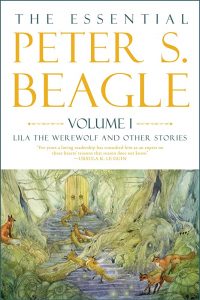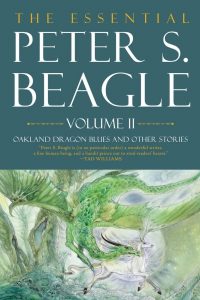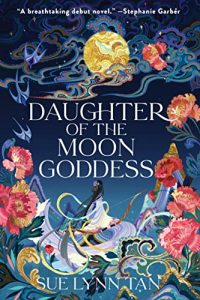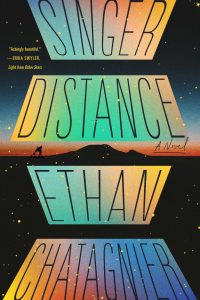Gary K. Wolfe Reviews The Essential Peter S. Beagle, Volume I: Lila the Werewolf and Other Stories and Volume II: Oakland Dragon Blues and Other Stories by Peter S. Beagle
 The Essential Peter S. Beagle, Volume I: Lila the Werewolf and Other Stories, Peter S. Beagle (Tachyon 978-1-61696-388-0, $28.95, 352pp, hc) May 2023.
The Essential Peter S. Beagle, Volume I: Lila the Werewolf and Other Stories, Peter S. Beagle (Tachyon 978-1-61696-388-0, $28.95, 352pp, hc) May 2023.
The Essential Peter S. Beagle, Volume II: Oakland Dragon Blues and Other Stories, Peter S. Beagle (Tachyon 978-1-61696-390-3, $28.95, 352pp, hc) May 2023.
Before anyone starts explaining it to me, I am fully aware that a word like “essential,” like most other words in publishing, is mainly a marketing term, but it’s an interesting one, since it can take on different meanings in different contexts. For a reprint program like Tor Essentials, it sounds a lot better than Backlist Favorites, even though no one is actually claiming that these books are so essential that failing to read them will leave you an out-of-touch buffoon. In other cases, like the massive The Essential Ellison 35 or so years ago, it can almost be an understatement: probably just about everything necessary to understand Ellison’s literary heritage is somewhere in that thousand or so pages, but you have to sort it out yourself from a lot of what we might politely describe as “optional” (though I personally think The Optional Ellison has a ring to it). Now here are the two volumes of The Essential Peter S. Beagle from Tachyon, which has done a wonderful job of showcasing Beagle’s work, both new and old, for more than 25 years. The title, of course, refers to short fiction, since no one is likely to argue that any “essential” Beagle could exclude The Last Unicorn, The Innkeeper’s Song, or A Fine and Private Place.
But there’s another meaning to “essential”, and it’s one that the Ellison and Beagle volumes have in common: what they can reveal not just about the work, but about the author. Even though many of the stories in The Essential Peter S. Beagle have appeared in earlier Tachyon collections (or in the Subterranean Press Best of Peter S. Beagle, edited by Jonathan Strahan), we come away from these volumes feeling we’ve gotten to know one of our greatest fantasists on an almost personal level. There are dragons, to be sure, and a few ghosts and werewolves, but what we will not find are the handful of Beagle stories set in the worlds of The Last Unicorn or The Innkeeper’s Song. Instead, many of the 33 stories here are drawn from Beagle’s own life – his best pals from a 1950s Bronx childhood, his social-realist artist uncles, the perils of studying for a Bar Mitzvah, affectionate tributes to lost friends (including Avram Davidson). There’s certainly a tone of nostalgia and loss hovering over such tales, but more importantly, they can serve as a master class in how memory and fantasy can work magic together.
For example, “The Rock in the Park” is set mostly around a rock in Van Cortlandt Park in the Bronx, which the Gunhill Gang – as Beagle and his pals called themselves – uses as a sort of secret meeting place. When they accidentally come upon a family of lost centaurs trying to make their way to refuge in Mexico, Phil, the artist of the group, assiduously sets out to draw maps showing them how to get there. The maps, of course, are as improbable as the centaurs themselves, but the story is, in addition to being a magical realist fable, a lovely tribute to an old friend. The most scientifically minded of the gang, Marty, gets his moment onstage in “Marty and the Messenger”, in which the lump of green Jell-O in his school lunch reveals itself to be a member of an alien civilization who needs his expertise. Scary or unnerving neighbors involve all the kids in “The Stickball Witch”, with its clever reversal on the familiar theme of the old lady so fearful that no one dares retrieve a ball from her yard, and “Mr. McCaslin”, a reclusive neighbor convinced he is doomed to die under a family curse. “The Fifth Season” culminates in an epic water-gun battle that briefly reveals haunting glances into the boys’ futures.
 That same childhood neighborhood also features prominently in both “The Rabbi’s Hobby” and “Uncle Chaim and Aunt Rifke and the Angel”. The former, which has long been among my favorite Beagle stories, juxtaposes the dilemma of a boy who despairs of ever learning enough Hebrew to stumble through his Bar Mitzvah with his kindly rabbi’s obsession with an anonymous young woman who appeared on a few magazine covers decades earlier. When another character enters the scene, the delicate blend of comic nostalgia and mystery takes an unexpected darker turn into a genuinely moving ghost story. The comic sensibility is even stronger in the tale of Uncle Chaim, in which an angel appears in the studio of an eccentric Jewish painter (loosely based on Beagle’s own well-known painter uncles), insisting on being a muse, but, as it turns out, bearing a much darker secret. Again, the point of view is that of the narrator recalling an odd episode from his elementary school days, and the tone of these tales is closer to that of Bernard Malamud or Isaac Bashevis Singer than to genre fantasy.
That same childhood neighborhood also features prominently in both “The Rabbi’s Hobby” and “Uncle Chaim and Aunt Rifke and the Angel”. The former, which has long been among my favorite Beagle stories, juxtaposes the dilemma of a boy who despairs of ever learning enough Hebrew to stumble through his Bar Mitzvah with his kindly rabbi’s obsession with an anonymous young woman who appeared on a few magazine covers decades earlier. When another character enters the scene, the delicate blend of comic nostalgia and mystery takes an unexpected darker turn into a genuinely moving ghost story. The comic sensibility is even stronger in the tale of Uncle Chaim, in which an angel appears in the studio of an eccentric Jewish painter (loosely based on Beagle’s own well-known painter uncles), insisting on being a muse, but, as it turns out, bearing a much darker secret. Again, the point of view is that of the narrator recalling an odd episode from his elementary school days, and the tone of these tales is closer to that of Bernard Malamud or Isaac Bashevis Singer than to genre fantasy.
Beagle’s main tribute to his old friend Avram Davidson, a writer regarded as a polymath by just about anyone who knew him, is “The Way It Works Out and All”, in which Davidson’s famously mercurial mind is translated into actual geography, as he sends Beagle daily postcards from places to which he could not possibly have traveled to so quickly – except that he’s discovered a kind of subreality transport system called the “overneath”. (Beagle seems so enamored of the notion that he used it as the title of a 2017 story collection.) If that sounds a bit like a tall tale, so does “The Mantichora”, in which a scholar identified only as “A.D.” travels to the Andes to interview the title beast, a surprisingly literate and chatty combination of Yeti and chimera whose disdain for the antics of humans is pretty acerbic. But the most deeply felt tribute to a lost friend is also one of the strongest and beautifully structured of Beagle’s stories, “A Dance for Emelia”. The narrator is a middle-aged actor who learns of the death of his close friend Sam, a failed dancer who later became a noted critic. Alternating memories of their school friendship and diverging careers with an account of settling the estate – and meeting for the first time the love of Sam’s life, Emelia, the story is a wise and masterful portrait of the meaning of deep friendship.
While there is a good deal of humor and snappy dialogue in many of these tales, some readers might be surprised at how funny Beagle can be in a more purely comic mode. “Oakland Dragon Blues” begins with a tired cop trying to persuade a depressed dragon to leave the intersection where it has planted itself, causing a traffic jam. In “The Best Worst Monster”, a resentful inventor sends his homemade monster out on trivial revenge missions, like demolishing the post office because it “never delivered any nice letters”. But even with these stories, Beagle often returns to themes of writing and the power of the imagination: the dragon is distraught because he was brought into the world by a writer who never finished the story he was in, and the inventor’s monster finds his soul when he encounters an itinerant poet. Farrell, the protagonist in “Spook”, finds his home haunted by a quarrelsome ghost whom he tries to get rid of by proposing a duel in which the weapons consist of bad poetry; the tale is largely an excuse for Beagle to showcase his favorite awful verses from the likes of William McGonagall and Julia A. Moore. “King Pelles the Sure” begins as an almost whimsical political fantasy reminiscent of the old novel and movie The Mouse that Roared – the title character worries that his kingdom is so peaceful and prosperous that it’s become boring, and he sets out seeking a war to glorify himself. But it soon turns into a grim and powerful antiwar fable.
While Beagle the humorist is on display in The Essential Peter S. Beagle, so is a darker side that sometimes approaches horror fiction. “We Never Talk About My Brother” basically asks what would happen if that terrifying kid from Jerome Bixby’s “It’s a Good Life” grew up to become a famous news anchor: the narrator’s brother, who since childhood has had the ability to retroactively erase from the world anyone who irritates or threatens him, uses his talent to promote the disasters that he reports on, until the narrator decides to confront him during a rare visit home. “The Bridge Partner” echoes the tone of Patricia Highsmith or Shirley Jackson with its quiet domestic setting, in which an unassuming small-town housewife meets the new member of her bridge group, who repeatedly and almost offhandedly whispers to her, “I will kill you.” One of the most familiar classics, “Come Lady Death”, describes a jaded noblewoman who invites Death to one of her parties, in an almost direct echo of Poe’s “The Masque of the Red Death”. “Lila the Werewolf”, by contrast, takes the material of classic horror and flips it into a kind of satirical rom-com set in contemporary Manhattan, describing the complications of having a live-in girlfriend who is a werewolf. Like many of the stories here, it’s a master class in using the materials of genre to forge a highly personal vision that almost always leads in surprising directions, revealing magic where we least expect it. At the end of “The Rock in the Park”, the narrator’s artist friend explains, “the artist isn’t the magic. The artist is the sight, the artist is someone who knows magic when he sees it. The magic doesn’t care whether it’s seen or not – that’s the artist’s business. My business.” That could be Beagle talking to us, and we’d do well to listen.
Gary K. Wolfe is Emeritus Professor of Humanities at Roosevelt University and a reviewer for Locus magazine since 1991. His reviews have been collected in Soundings (BSFA Award 2006; Hugo nominee), Bearings (Hugo nominee 2011), and Sightings (2011), and his Evaporating Genres: Essays on Fantastic Literature (Wesleyan) received the Locus Award in 2012. Earlier books include The Known and the Unknown: The Iconography of Science Fiction (Eaton Award, 1981), Harlan Ellison: The Edge of Forever (with Ellen Weil, 2002), and David Lindsay (1982). For the Library of America, he edited American Science Fiction: Nine Classic Novels of the 1950s in 2012, with a similar set for the 1960s forthcoming. He has received the Pilgrim Award from the Science Fiction Research Association, the Distinguished Scholarship Award from the International Association for the Fantastic in the Arts, and a Special World Fantasy Award for criticism. His 24-lecture series How Great Science Fiction Works appeared from The Great Courses in 2016. He has received six Hugo nominations, two for his reviews collections and four for The Coode Street Podcast, which he has co-hosted with Jonathan Strahan for more than 300 episodes. He lives in Chicago.
This review and more like it in the March 2023 issue of Locus.
 While you are here, please take a moment to support Locus with a one-time or recurring donation. We rely on reader donations to keep the magazine and site going, and would like to keep the site paywall free, but WE NEED YOUR FINANCIAL SUPPORT to continue quality coverage of the science fiction and fantasy field.
While you are here, please take a moment to support Locus with a one-time or recurring donation. We rely on reader donations to keep the magazine and site going, and would like to keep the site paywall free, but WE NEED YOUR FINANCIAL SUPPORT to continue quality coverage of the science fiction and fantasy field.
©Locus Magazine. Copyrighted material may not be republished without permission of LSFF.








